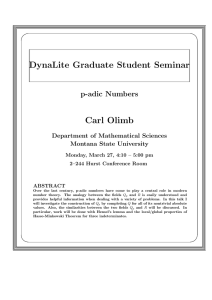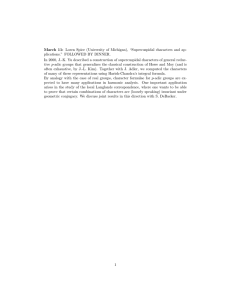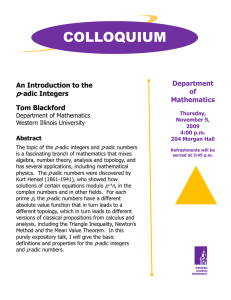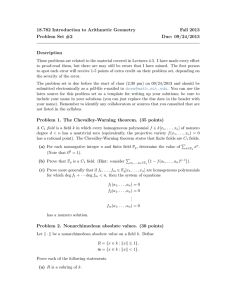Dynamics of the p -adic Shift and Applications Please share
advertisement
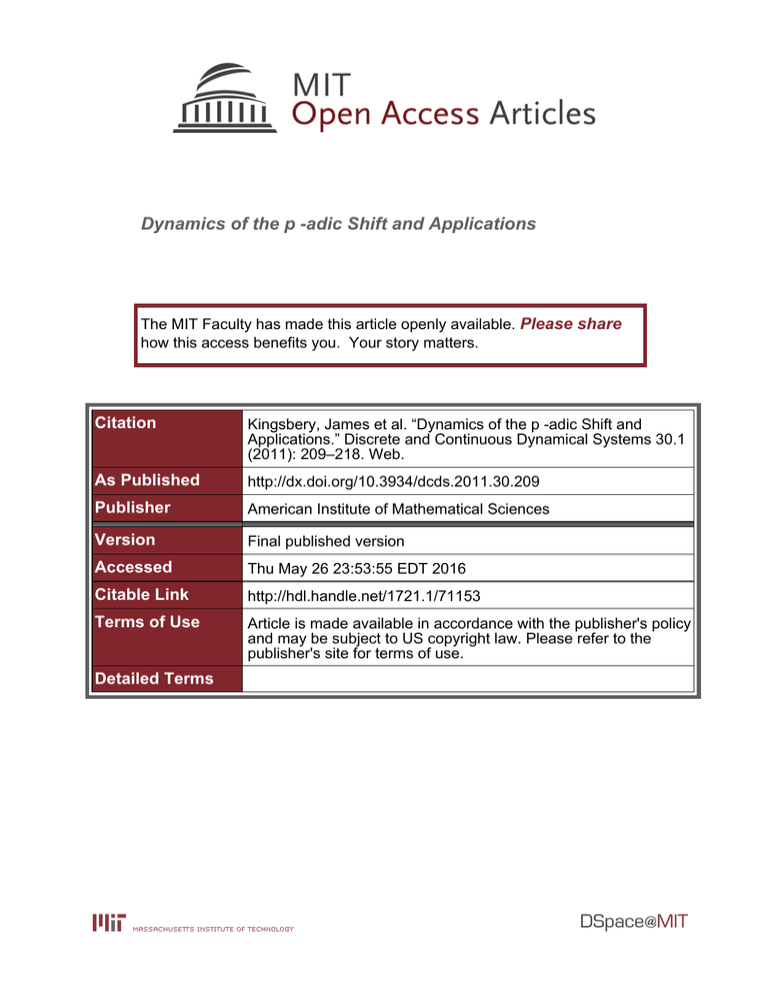
Dynamics of the p -adic Shift and Applications
The MIT Faculty has made this article openly available. Please share
how this access benefits you. Your story matters.
Citation
Kingsbery, James et al. “Dynamics of the p -adic Shift and
Applications.” Discrete and Continuous Dynamical Systems 30.1
(2011): 209–218. Web.
As Published
http://dx.doi.org/10.3934/dcds.2011.30.209
Publisher
American Institute of Mathematical Sciences
Version
Final published version
Accessed
Thu May 26 23:53:55 EDT 2016
Citable Link
http://hdl.handle.net/1721.1/71153
Terms of Use
Article is made available in accordance with the publisher's policy
and may be subject to US copyright law. Please refer to the
publisher's site for terms of use.
Detailed Terms
DISCRETE AND CONTINUOUS
DYNAMICAL SYSTEMS
Volume 30, Number 1, May 2011
doi:10.3934/dcds.2011.30.209
pp. 209–218
DYNAMICS OF THE p-ADIC SHIFT AND APPLICATIONS
James Kingsbery
400 E 71 St. Apt. 5B
New York, NY 10021, USA
Alex Levin and Anatoly Preygel
Massachusetts Institute of Technology
Cambridge, MA 02139, USA
Cesar E. Silva
Williams College
Williamstown, MA 01267, USA
(Communicated by Dmitry Kleinbock)
Abstract. There is a natural continuous realization of the one-sided Bernoulli
shift on the p-adic integers as the map that shifts the coefficients of the p-adic
expansion to the left. We study this map’s Mahler power series expansion. We
prove strong results on p-adic valuations of the coefficients in this expansion,
and show that certain natural maps (including many polynomials) are in a
sense small perturbations of the shift. As a result, these polynomials share the
shift map’s important dynamical properties. This provides a novel approach
to an earlier result of the authors.
1. Introduction. In recent years, several authors have studied the dynamics that
result from various maps on the p-adics. In many cases they have shown that relatively simple and natural transformations satisfy important dynamical properties,
such as ergodicity. For an overview of this work, the reader may refer to the recent
monographs [1, 6, 11], the survey [3], and the references therein. General references
are in [5, 9, 10].
In this paper, we continue this line of research by considering noninvertible
Bernoulli transformations on the p-adic integers. Bernoulli transformations are
those isomorphic with the “left shift” of infinite sequences on some alphabet. They
are ubiquitous throughout the field of dynamics, and come up in numerous guises
in several branches of mathematics. In measurable dynamics, the map Tn : [0, 1] →
[0, 1] for n a positive integer, taking x to nx mod 1, provides a simple example of
a (noninvertible) Bernoulli transformation. Taking base-n expansions of x, and ignoring the (measure zero) set of redundant expansions .n − 1, one sees that indeed
this map is just a left shift.
Moving to the p-adic context, the aim of this paper is to present a novel way of
realizing the one-sided Bernoulli shift on p symbols, where p is some prime. We
do this by starting with the most natural realization:
Any x ∈ Zp has a unique
P
i
(possibly infinite) expansion of the form x = ∞
b
p
(b
i ∈ {0, 1, . . . , p − 1}); one
i=0 i
2000 Mathematics Subject Classification. Primary 37A05; Secondary 37F10.
Key words and phrases. Measure-preserving, ergodic, Bernoulli, shift, p-adic.
209
210
JAMES KINGSBERY, ALEX LEVIN, ANATOLY PREYGEL AND CESAR E. SILVA
can defineP
the “p-adic shift” S : Zp → Zp to be a left shift on this expansion, that
i
is S(x) = ∞
i=0 bi+1 p . By showing that suitably small perturbations of S are still
Bernoulli, we can find many “nice” maps, such as polynomials, that behave like
the shift map S in this way. We originally discussed these maps in [7]; this paper
presents a novel and more direct way of obtaining them, as we will remark below,
and it can be read independently of [7]. Because we are working on the p-adics,
our proofs use divisibility properties of certain polynomials, and thus, we obtain a
connection between dynamics and number theory.
Our work was motivated by the article [3], which studied the measurable dynamics of polynomial maps on Zp . The authors in [3] asked when polynomial maps
can satisfy the measurable dynamical property of being mixing. (It turns out that
this was known to Woodcock and Smart, who showed in [13] that the polynomial
p
map x 7→ x p−x defines a Bernoulli, hence mixing, transformation on Zp .) In [7],
the authors gave a detailed account of the dynamics that can result from a certain
well-behaved class of maps on the p-adics. In particular, we introduced a set of
conditions on the Mahler expansion of a transformation on the p-adics which are
sufficient for it to be Bernoulli (see Definition 3.10). We call the class of maps
meeting those conditions the Mahler-Bernoulli class.
The sufficiency of these conditions was proved in [7] via a structure theorem
for so-called “locally scaling” transformations (see Definition 3.1). The MahlerBernoulli class conditions mentioned above
were (roughly) that the transformation
be a small enough perturbation of x 7→ xp (which is part of the Mahler basis), and
so applying the
structure theorem required a careful study of the dynamics of the
map x 7→ xp , including showing that it is Bernoulli. The approach of the present
paper turns out to be more direct than that of [7], to which it is in a sense dual:
we begin with the easily understood dynamics of S and work to better understand
its Mahler expansion, proving that it is “well-approximated” by x 7→ xp . Since we
are working in an ultrametric setting, the Mahler-Bernoulli class conditions may be
reformulated as defining exactly those maps that are small enough perturbations of
S, giving a more conceptual reason why they should be Bernoulli!
This paper is organized as follows. We begin by studying the p-adic shift and its
properties. Section 3 is devoted to developing our machinery and proving the main
result. We introduce locally scaling transformations (similarly to our discussion
in [7]) and then show what we mean when we say that certain maps are small
perturbations of the shift map. At the end of the section, we prove that certain
locally scaling transformations are indeed small perturbations of the shift map, and
hence Bernoulli. In particular, we define the Mahler-Bernoulli class and show that
all members thereof satisfy these properties. Finally, in Section 4 we briefly talk
about maps related to the p-adic shift.
We have discussed locally scaling transformations and their dynamical properties
in [7]. However, the interpretation that certain locally scaling transformations are
in some sense small perturbation on the shift map, and therefore remain Bernoulli,
is original to this paper (and is its main contribution).
The p-adic shift map has been previously investigated by other researchers. In
particular, ergodicity of the p-adic shift was established in [8]. Conditions for the
equivalence of a quadratic map to the shift were studied in [12], and a realization
of the Smale horseshoe map as a shift on Zp × Zp was considered in [2].
p-ADIC SHIFT AND APPLICATIONS
211
2. The p-adic shift. Throughout the rest of this paper, we fix a prime p, and let
| · | be the p-adic absolute value.
The p-adic shift S : Zp −→ Zp is defined as follows. If x = b0 + b1 p + b2 p2 + · · · ,
where the bi ∈ {0, 1, . . . , p − 1}, we let S(x) = b1 + b2 p + b3 p2 + · · · . We immediately
see that if S k denotes the k-fold iterate of S, then we have that Sk (x) = bk +
bk+1 p + · · · . Moreover, for x ∈ Z, it is the case that S k (x) = x/pk where b·c is
the greatest integer function.
Clearly, the shift is continuous on Zp with respect to the p-adic metric (where
the distance between x and y is |x − y|).
By Mahler’s Theorem, any continuous T : Zp −→ Zp can be expressed in the
form of a uniformly convergent series, called its Mahler Expansion:
∞
X
x
T (x) =
an
n
n=0
where
an =
n
X
n
(−1)n+i T (i)
∈ Zp
i
i=0
(1)
Remark 2.1. For an arbitrary
function
T : Zp → Zp , we can write down the
P∞
x
for
coefficients
an ∈ Zp to be determined.
formal identity T (x) =
a
n
n=0
n
Then, substituting in x = 0, 1, 2, . . . in turn, we can inductively determine that
the an would have to be as in (1), noting that only finitely many summands will
be non-zero at each stage. The true content of Mahler’s Theorem is that for T
continuous on Zp , this series converges, which happens if and only if |an | → 0 as
n → ∞ by convergence properties on the p-adics.
Our first goal is to study the Mahler expansion of S k . Throughout this paper,
(k)
we let an be the nth Mahler coefficient of S k . In other words, we have
S k (x) =
∞
X
an(k)
n=0
x
.
n
(k)
Theorem 2.2. The coefficients an satisfy the following properties:
(k)
(i) an = 0 for 0 ≤ n < pk ;
(k)
(ii) an = 1 for n = pk ;
(k)
(k)
(iii) Suppose j ≥ 0. Then, pj divides an for n > jpk −j+1 (and so, |an | ≤ 1/pj ).
Proof. Our proof is closely based on Elkies’s short derivation of Mahler’s Theorem
[4]. Let
F (t) =
X
S k (n)tn ∈ Zp [[t]]
and
n≥0
A(u) =
X
n
a(k)
n u ∈ Zp [[u]].
n≥0
Recall the standard power series identities
X
1
=
ti
1−t
i≥0
and
X
t
=
iti .
(1 − t)2
i≥1
212
JAMES KINGSBERY, ALEX LEVIN, ANATOLY PREYGEL AND CESAR E. SILVA
Using them and the definition of S k , we may compute that
F (t) =
X
S k (n)tn =
k
pX
−1
=
=
a=0
k
bta+bp
a=0 b≥0
n≥0
k
pX
−1 X
t
b
=
1
F
A(u) =
1+u
a
k
X
k
p
b(t )
b≥0
tp
(1 − t)(1 − tpk )
k
1 − tp
1−t
!
k
tp
(1 − tpk )2
!
Before proceeding, we remark that
u
1+u
.
(2)
P
Indeed, suppose T : Zp → Qp is any map. Set F̃ (t) = n≥0 T (n)tn and Ã(u) =
P
P
n
n
i ai i = T (n) for all k ≥ 0. Then,
n≥0 an u where an is such that
n
XX
n n X X n n X
ti
t =
ai
ai
t =
ai
F̃ (t) =
i
i
(1 − t)i+1
i≥0
n≥i
i≥0
n≥0 i=0
X i
t
1
1
t
=
=
ai
Ã
1−t
1−t
1−t
1−t
i≥0
From this, (2) follows by taking F̃ = F, Ã = A, and t = u/(1 + u).
k
k
k
Now, note that because p| pi for all 0 < i < pk , we have (1 + u)p − up =
1 + pR(u) where R(u) is a polynomial of degree pk − 1 in u without leading term,
so that
k
u
1
up
,
F
A(u) =
=
1+u
1+u
(1 + u)pk − upk
k
which is equal to up 1 + pR(u) + p2 R(u)2 + p3 R(u)3 + · · · . Since R(u) has no
leading term, we can now conclude (i) and (ii). The case j = 0 of (iii) is trivial, so
we may assume j ≥ 1. Working modulo pj we obtain the equality (in (Zp /pj Zp )[[u]])
k
A(u) ≡ up 1 + pR(u) + · · · + pj−1 R(u)j−1
(mod pj )
Note that the right hand side is a polynomial of degree pk + (j − 1)(pk − 1) =
jpk − j + 1. This allows us to conclude (iii).
As we will see, the next corollary will be of fundamental importance in the
following section, where we try to bound coefficients in the Mahler expansions of
maps related to the shift.
(k)
Corollary 2.3. The maximum possible value for pblogp nc |an | is pk and it is attained only when n = pk .
(k)
(k)
Proof. We may assume an 6= 0. Let vp (an ) denote the integer ` so that p`
(k)
(k)
precisely divides an . We are asked to prove that logp n − vp (an ) ≤ k with
equality if and only if n = pk . Setting ` = logp n − k, we are thus to show that p`
(k)
divides an and p`+1 divides it unless n = pk .
p-ADIC SHIFT AND APPLICATIONS
213
Note that p` ≥ ` so that
n ≥ pblogp nc = p` pk ≥ `pk ≥ `pk − ` + 1
(k)
and applying Theorem 2.2 yields that p` does in fact divide an .
If ` > 0, then p` ≥ `+1 so that we in fact have n ≥ (`+1)pk ≥ (`+1)pk −(`+1)+1
(k)
(k)
and so Theorem 2.2 yields that p`+1 does in fact divide an . Since an = 0 for
(k)
n < pk , by Theorem 2.2, it suffices to prove that p divides an for n > pk ; but this
is immediate from Theorem 2.2.
3. Perturbing the shift.
3.1. Local scaling. The shift S cuts off the first digit term in the p-adic expansion
of x ∈ Zp . Notice that if the expansions of x and y agree on the first digit (i.e.
|x − y| ≤ 1/p), then S multiplies the distance between them by p. Thus, S scales
distances between points that are close enough.
This observation motivates the following definition from [7].
Definition 3.1. We say that T : Zp −→ Zp is locally scaling with scaling radius r
and scaling constant C ≥ 1, and write that T is (r, C)-locally scaling, if for all x, y
with |x − y| ≤ r, we have |T (x) − T (y)| = C|x − y|. We will always assume, without
loss of generality, that r = p` and C = pm , where ` ≤ 0 and m ≥ 0.
Proposition 3.2. The map S k is (p−k , pk )-locally scaling.
Proof. Immediate.
Notice that if T is a locally scaling map, it is continuous, and for r0 ≤ r, the
restriction T |Br0 (x) is injective into BCr0 (T (x)) . It is surjective as well, as the
following lemma in [7] shows; the proof is included for completeness.
Proposition 3.3. For T an (r, C)-locally scaling map and r0 ≤ r, the restricted
map T |Br0 (x) : Br0 (x) −→ BCr0 (T (x)) is a bijection.
Proof. Let S = T |Br0 (x) . Because injectivity of S is clear, we just prove surjectivity.
Let B ⊂ BCr0 (T (x)) be a ball of radius p−j ≤ Cr0 for j ∈ Z≥0 . Assume furthermore
that there are η balls of radius (1/C) p−j contained in Br0 (x) . Pick one point in each
of these balls of radius (1/C) p−j (the representative of that ball). Because these η
representatives are all at least (1/C) p−j apart from one another and (1/C) p−j ≤ r0 ,
their images have to be at least p−j apart from one another by local scaling. Thus,
they have to occupy η distinct balls of radius p−j in the range. Finally, because
the number of balls of radius p−j contained in BCr0 (T (x)) is also η, one of the
representatives in Br0 (x) must map into B by the pigeonhole principle.
We conclude that the image of S is dense in BCr0 (T (x)) . Then, since S is
continuous and Br0 (x) is compact, S(Br0 (x)) must be closed. Thus it is all of
BCr0 (T (x)) .
3.2. (p−k , pk )-locally scaling maps. We now turn our attention to a special case
of local scaling, the (p−k , pk )-locally scaling maps. We will see that they behave
“nicely” under preimages. More precisely, when one takes the preimage of a given
ball, the result is a union of smaller balls that are very evenly distributed throughout
Zp .
We recall that for each k ≥ 1, the set Zp can be partitioned into pk balls of radius
−k
p and we shall refer to these as the balls of radius p−k in Zp . Also, we denote
214
JAMES KINGSBERY, ALEX LEVIN, ANATOLY PREYGEL AND CESAR E. SILVA
Figure 1.
An illustration of the local nesting property for
(1/3, 3)-locally scaling maps. Let B be the big ball at the bottom of the figure; the arrows lead to its preimages B1 , B2 , and B3 .
The shaded ball inside B is some B 0 . Its preimage consists of the
balls B10 , B20 and B30 , one inside each of the Bi . The figure should
not be taken to imply that B and the Bi are disjoint; in fact, if
B = Zp , it will contain all the Bi .
Haar measure on Zp by µ and recall that it is completely determined by its value
on balls, the measure of each ball being its radius.
Let T be a (p−k , pk )-locally scaling map. In this case, each of the pk balls of
radius p−k in Zp is mapped bijectively onto Zp . It follows that given a ball B ⊂ Zp
of radius p−j , with j ≥ k, its preimage is
k
T
−1
(B) =
p
G
Bi
i=1
where each Bi is a ball of radius p−(j+k) , and the Bi are contained in distinct balls
0
of radius p−k . Furthermore, if B 0 ⊂ B is a ball of radius p−j ≤ p−j , then
k
T
−1
0
(B ) =
p
G
Bi0
i=1
Bi0
−(j 0 +k)
where each
is a ball of radius p
, and each Bi0 is contained in Bi . We
call this very nice property of preimages the nesting property (see Figure 1 for an
illustration).
We have proved:
Lemma 3.4. Let T : Zp −→ Zp be (p−k , pk )-locally scaling. Suppose that B is a ball
of radius p−kj . Then, T −1 (B) consists of a union of pk balls of radius p−k(j+1) , one
inside each ball of radius p−k in Zp . In particular, T is Haar measure-preserving.
3.3. Connections with Bernoulli maps. With our setup, we will be able to say
that certain maps (namely the (p−k , pk )-locally scaling ones) in many senses behave
“the same” as the p-adic Bernoulli shift (or one of its iterates). To make these
p-ADIC SHIFT AND APPLICATIONS
215
notions more precise, we introduce some concepts in topological and measurable
dynamics.
Definition 3.5. Two maps T : Zp −→ Zp and S : Zp −→ Zp are said to be
topologically isomorphic if there exists a homeomorphism Φ : Zp −→ Zp such that
Φ ◦ T (x) = S ◦ Φ(x)
(3)
for all x.
The maps are measurably isomorphic if there exists an invertible and measurepreserving map Φ such that (3) holds for almost all x in Zp .
Close variants of the following theorem and proof are in [7].
Theorem 3.6. Let T : Zp −→ Zp be a (p−k , pk )-locally scaling map. Then T is
topologically and measurably isomorphic to S k .
Proof. We will find a measure-preserving homeomorphism Φ : Zp −→ Zp such that
Φ ◦ T = S k ◦ Φ. Consider
∞
X
di (x)pi ,
Φ(x) =
i=0
where, if i = qk+r for integer q and r with 0 ≤ r < k, we have that di (x) = (T q (x))r
(the rth digit in the p-adic expansion of T q (x)). From this definition, it is easy to
see that Φ ◦ T (x) = S k ◦ Φ(x) for all x ∈ Zp .
We now proceed to show that Φ, as defined, is continuous, bijective and measurepreserving. Because Zp is compact, continuity of the inverse follows by general facts
in topology. Therefore, we will have proved that Φ is a homeomorphism.
To show that Φ is continuous, suppose that |x − y| ≤ p−kη for η ≥ 1. It follows
by local scaling that |T (x) − T (y)| ≤ p−k(η−1) , and in general, we can see that for
q ≤ η − 1, we have that |T q (x) − T q (y)| ≤ p−k . Therefore, the p-adic expansions of
Φ(x) and Φ(y) agree at least up to the p−(kη−1) term, and we see that |Φ(x)−Φ(y)| ≤
p−kη . Continuity follows.
To show injectivity, suppose that Φ(x) = Φ(y). Then, |T i (x) − T i (y)| ≤ p−k for
all i ≥ 0. But if |T i (x) − T i (y)| 6= 0 for some i, it follows by local scaling that there
is a j ≥ 0 such that |T i+j (x) − T i+j (y)| > p−k , a contradiction.
Suppose that y ∈ Zp and η ≥ 1. From the definition of Φ, it is clear that
x ∈ Φ−1 Bp−kη (y)
if and only if
x ∈ Bp−k (y)
T (x) ∈ Bp−k S k (y)
..
.
T η−1 (x)
∈ Bp−k S (η−1)k (y) .
The balls of radius p−kη for η ≥ 1 generate the Borel σ-algebra of Zp . So, in order
to prove that Φ is measure-preserving it suffices to prove that
µ Φ−1 Bp−kη (y) = µ Bp−kη (y) = p−kη .
Since Zp is compact, this will also imply that Φ is surjective since Φ−1 (y) will then
be the descending intersection of nonempty closed sets.
216
JAMES KINGSBERY, ALEX LEVIN, ANATOLY PREYGEL AND CESAR E. SILVA
We will prove by induction on η ≥ 0 that Φ−1 Bp−kη (y) is a single ball of
radius p−kη . The case η = 0 is immediate. If η ≥ 1, then
\
η−1
T −i Bp−k S ik (y)
Φ−1 Bp−kη (y) =
i=0
= Bp−k (y) ∩ T −1
η−1
\
T −(i−1) Bp−k
i=1
= Bp−k (y) ∩ T −1 Φ−1 Bp−k(η−1) S k y
S ik (y)
!
is a ball of radius p−kη by the inductive hypothesis and Lemma 3.4.
3.4. “Small” perturbations on S k . At this point in the presentation, we have
determined that (p−k , pk )-locally scaling maps are Bernoulli. Furthermore, by understanding the Mahler expansion of the shift map S k , as we did earlier, we hope
to understand the scaling
properties of polynomial maps (namely, finite Zp -linear
combinations of the nx ), and thus, to find Bernoulli polynomials. As we will see,
we have an infinite class of polynomial maps such that any g in this class can be
written as a sum of S k and a perturbing factor satisfying the Lipschitz property
(see below). In turn, this perturbing factor has small enough Lipschitz constant so
that g is (p−k , pk )-locally scaling, like S k . We proceed to lay the groundwork for
this argument.
Definition 3.7. A function T : Zp −→ Zp is C-Lipschitz if |T (x)− T (y)| ≤ C|x− y|
for all x, y ∈ Zp .
If T is C-Lipschitz and a ∈ Qp , it is clear that aT is |a|C-Lipschitz.
Also, because
P
of the strong triangle inequality, if Ti is Ci -Lipshitz,
Ti is (supi {Ci })-Lipshitz,
provided this supremum exists (i.e., the Ci are bounded).
Lipshitz maps are important in our discussion because they provide us with a
way of slightly modifying a locally scaling function such that the resulting map is
still locally scaling. The following proposition demonstrates one such method.
Proposition 3.8. Let T : Zp −→ Zp be (r, C)-locally scaling, S : Zp −→ Zp be DLipshitz with D < C, and suppose that u ∈ Z×
p = {Zp : |x| = 1}. Then T̃ = uT + S
is (r, C)-locally scaling.
Proof. Take x and y with |x − y| ≤ r. Then
|T̃ (x) − T̃ (y)| =
=
|(uT (x) + S(x)) − (uT (y) + S(y))|
|u(T (x) − T (y)) + (S(x) − S(y))|.
But, |u(T (x) − T (y))| = C|x − y| > D|x − y| ≥ |S(x) − S(y)|. Therefore, we see that
|T̃ (x) − T̃ (y)| = C|x − y|, as desired.
In particular, if f˜(x) = S k (x) + b(x) where b is pk−1 -Lipshitz, then f˜ is (p−k , pk )locally scaling, and hence Bernoulli. This condition gives us sufficient conditions
on the Mahler expansion of a continuous map T : Zp −→ Zp for the map to be
isomorphic to S k for some k.
Before stating the result, however, we need the following standard lemma:
Lemma 3.9. The Zp map x 7→ nx is pblogp nc -Lipshitz for all n.
Proof. See [9, pg. 227].
p-ADIC SHIFT AND APPLICATIONS
217
Definition 3.10. Let T (x) be given by the uniformly converging Mahler series
∞
X
x
T (x) =
An
n
n=0
and set C = maxn pblogp nc |An |. Suppose that the following conditions hold:
• There exists a unique n0 which attains this maximum;
• n0 = pk for some k > 0;
• |An0 | = 1 (thus, C = n0 = pk ).
Then, we say that T is in the Mahler-Bernoulli class.
Theorem 3.11. Let T be in the Mahler-Bernoulli class, with C = pk as in the
definition. Then T is (p−k , pk )-locally scaling and hence isomorphic to S k .
Proof. A variant of this theorem is in [7]. The proof that follows uses the Mahler
expansion of S k , and is original to this paper.
The idea of the proof is that by the Mahler-Bernoulli class conditions, the Apk pxk
term will be the dominant one in determining the scaling behavior of T. Indeed, as
we will see below, after multiplying by a unit as appropriate, T and S k differ by a
pk−1 -Lipshitz component; this follows by the Mahler-Bernoulli class conditions, as
well as the tight control guaranteed by Lemma 3.9. The details of this argument
are below.
(k)
Recall that for the map S k , we have that apk = 1. Therefore, the fact that
|Apk | = 1 in the Mahler expansion of T implies that there exists u ∈ Z×
p such
(k)
(k)
that uapk = Apk . Consider the general term bn = uan − An . By choice of u,
we have bpk = 0. Furthermore, the strong triangle inequality tells us that |bn | ≤
(k)
max{|an |, An }. Regardless of what the maximum is for a particular n 6= pk , it is
the case that |bn |pblogp nc < pk by definition and Corollary 2.3. Therefore, using
Lemma 3.9, we see that bn nx is pk−1 -Lipshitz for all n (since bpk = 0, the claim is
trivial for n = pk ).
P∞
Hence, uS k (x) − T (x) = n=0 bn nx is pk−1 -Lipshitz. This implies, by Proposition 3.8, that T is (p−k , pk )-locally scaling and the theorem follows.
Remark 3.12. The reader may (rightly) point out that proving the local scaling
properties of maps like pxk should not be much harder than proving Lipschitz
properties of the nx , which we did not demonstrate in this paper, but rather quoted
from a standard text. Indeed, the local scaling proof was done directly in [7]. Going
through the Mahler expansion of the shift map provides us with not as much a
new proof of the local scaling properties, but an interpretation of the maps in the
Mahler-Bernoulli class, which satisfy them.
4. Other related maps. The p-adic shift is actually a special case of another
natural class of maps. First off,Pdefine g : Qp −→ Zp as follows. Given x ∈ Qp , we
∞
can express it uniquely as x = i=` bi pi where ` ≤ 0 and bi ∈ {0, 1, . . . , p − 1} for
all i.
P∞
With our setup notation, we let g(x) = i=0 bi pi . In other words, g chops off
the negative powers of p in the p-adic expansion of x.
Take a ∈ Qp . Define fa : Zp −→ Zp by fa (x) = g(ax) where g is as above. Notice
that the p-adic shift is fa where a = 1/p.
218
JAMES KINGSBERY, ALEX LEVIN, ANATOLY PREYGEL AND CESAR E. SILVA
We will mostly be interested in fa with |a| > 1. Now, |a| > 1 implies that
0
k
a = a0 /pk for a0 ∈ Z×
p and k > 0. Therefore, for x ∈ Zp , fa (x) = g(a x/p ) where
a0 x ∈ Zp and so, fa (x) = S k (a0 x).
We now make a few remarks about the topological dynamics of the maps fa .
For a with |a| < 1, we have that fa (Zp ) ( Zp , so fa is not surjective, and cannot
be isomorphic to the shift.
The situation when |a| > 1 is quite different.
Theorem 4.1. For |a| = pk , with k > 0, fa is (p−k , pk )-locally scaling, and hence
isomorphic to S k .
Proof. We know that fa (x) = S k (a0 x) where a0 ∈ Z×
p . Take x and y with |x − y| ≤
−k
0
0
−k
p . Then, |a x − a y| = |x − y| ≤ p . Therefore,
|S k (a0 x) − S k (a0 y)| = pk |a0 x − a0 y| = pk |x − y|
and so fa is (p−k , pk )-locally scaling.
Acknowledgments. This paper is based on research by the Ergodic Theory group
of the 2005 SMALL summer research project at Williams College. Support for the
project was provided by National Science Foundation REU Grant DMS – 0353634
and the Bronfman Science Center of Williams College. We would like to thank the
referee for suggestions and for references [2, 8, 12].
REFERENCES
[1] V. Anashin and A. Khrennikov, “Applied Algebraic Dynamics,” volume 49 of de Gruyter
Expositions in Mathematics, Walter de Gruyter & Co., Berlin, 2009.
[2] D. K. Arrowsmith and F. Vivaldi, Some p-adic representations of the Smale horseshoe, Phys.
Lett. A, 176 (1993), 292–294.
[3] J. Bryk and C. E. Silva, Measurable dynamics of simple p-adic polynomials, Amer. Math.
Monthly, 112 (2005), 212–232.
[4] N. D. Elkies, Mahler’s theorem on continuous p-adic maps via generating functions,
http://www.math.harvard.edu/~ elkies/Misc/mahler.pdf.
[5] F. Q. Gouvêa, “p-adic Numbers, An Introduction,” Universitext. Springer-Verlag, Berlin,
1993.
[6] A. Yu. Khrennikov and M. Nilson, “p-adic Deterministic and Random Dynamics,” volume
574 of Mathematics and its Applications, Kluwer Academic Publishers, Dordrecht, 2004.
[7] J. Kingsbery, A. Levin, A. Preygel, and C. E. Silva, On measure-preserving C 1 transformations of compact-open subsets of non-Archimedean local fields, Trans. Amer. Math. Soc., 361
(2009), 61–85.
[8] A. V. Mikhaı̆lov, The central limit theorem for a p-adic shift. I, in “Analytic Number Theory
(Russian),” Petrozavodsk. Gos. Univ., Petrozavodsk, (1986), 60–68, 92.
[9] A. M. Robert, “A Course in p-adic Analysis,” volume 198 of Graduate Texts in Mathematics,
Springer-Verlag, New York, 2000.
[10] C. E. Silva, “Invitation to Ergodic Theory,” volume 42 of Student Mathematical Library,
American Mathematical Society, Providence, RI, 2008.
[11] J. H. Silverman, “The Arithmetic of Dynamical Systems,” volume 241 of Graduate Texts in
Mathematics, Springer, New York, 2007.
[12] D. Verstegen, p-adic dynamical systems, in “Number Theory and Physics (Les Houches,
1989),” volume 47 of Springer Proc. Phys., Springer, Berlin, (1990), 235–242.
[13] C. F. Woodcock and N. P. Smart, p-adic chaos and random number generation, Experiment.
Math., 7 (1998), 333–342.
Received March 2010; revised July 2010.
E-mail address: 06jameskingsbery@gmail.com;levin@mit.edu
E-mail address: preygel@mit.edu;csilva@williams.edu
